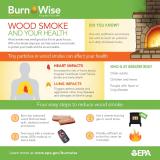Wood Smoke and Your Health
- What is wood smoke?
- Health effects of wood smoke
- Who is at risk from wood smoke?
- Wood smoke and COVID-19
- Environmental effects
- Related Information
What is wood smoke?
Smoke forms when wood or other organic matter burns. The smoke from wood burning is made up of a complex mixture of gases and fine particles (also called particle pollution, particulate matter, or PM). In addition to particle pollution, wood smoke contains several toxic air pollutants including:
The more efficiently you burn wood (e.g., using an EPA-certified wood stove and dry, seasoned wood) the less smoke is created.
Health effects of wood smoke
Smoke may smell good, but it's not good for you. The biggest health threat from smoke is from fine particles, also called fine particulate matter or PM2.5. These microscopic particles can get into your eyes and respiratory system, where they may cause burning eyes, runny nose, and illnesses, such as bronchitis.
Fine particles can make asthma symptoms worse and trigger asthma attacks. Fine particles can also trigger heart attacks, stroke, irregular heart rhythms, and heart failure, especially in people who are already at risk for these conditions.
Learn more about the health and environmental effects of fine particles.
Who is at risk from wood smoke?
-
If you have heart or lung disease, such as congestive heart failure, angina, chronic obstructive pulmonary disease, emphysema or asthma, you may experience health effects earlier and at lower smoke levels than healthy people.
-
Older adults are more likely to be affected by smoke, possibly because they are more likely to have chronic heart or lung diseases than younger people.
-
Children also are more susceptible to smoke for several reasons:
-
their respiratory systems are still developing,
-
they breathe more air (and air pollution) per pound of body weight than adults, and
-
they are more likely to be active outdoors.
-
Learn how to reduce wood smoke and lower your risk.
Wood smoke and COVID-19
Wood smoke can irritate your lungs, cause inflammation, affect your immune system, and make you more prone to lung infections, likely including SARS-CoV-2, the virus that cause COVID-19. According to information provided on CDC's website, Exitpeople who currently have or who are recovering from COVID-19 may be at an increased risk of health effects from exposure to wood smoke due to compromised heart and/or lung function related to COVID-19.
If you are recovering from COVID-19, or are at increased risk for COVID-19, Exittake steps to reduce your exposure to wood smoke. See additional information on wood smoke and COVID-19.
|
Know the difference between symptoms from smoke exposure and COVID-19 |
|---|
|
|
|
| For more information about COVID-19, go to CDC's Coronavirus (COVID-19) webpage.EXIT |
Environmental effects of wood smoke
The particles in wood smoke can reduce visibility (haze). Particles can also create environmental and aesthetic damage in our communities and scenic areas – like national parks. Health resources
Related Information
Health resources
Asthma resources
Outreach materials

